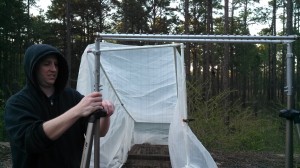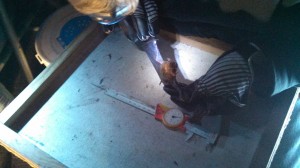Over the past week, I’ve been looking into when and how scientists first became aware of white-nose syndrome in northeast bats, as well as what the loss of those bats could mean for all of us. It’s pretty depressing reading on the whole- especially when you realize that it has developed so quickly.

When bats fly into the strings of the harp trap, they fall into the bag below and can be examined by researchers.
What were the first hints that something was wrong? I’m quite sure of the how and where, but the when on this one seems to be unresolved- according to the USDA in February 2006 (or during the winter of 2006/2007 according to US Fish & Wildlife, or in February 2007 according to a 2008 article in BioScience [Cohn 2008]), dead and dying bats were found in a cave near Albany, NY. Some affected bats featured white fungal spores on their faces which both suggested some type of infection and gave the disease its name. By 2010, the problem had spread more than 1300 km and infected caves had been found throughout much of the Northeast and into Canada (Wibbelt et al. 2010). I saw a range of estimates for mortality- one suggested that over 1 million bats had died by 2010 (Cryan et al. 2010); another that losses at individual hibernacula topped 75% (Bolyes & Willis 2010); and a third reported that at a mine in Vermont where scientists had previously captured 900 bats, only one had been captured in 2009 ( really?! That’s terrifying! [Burton 2009]). 6 species of bats which hibernate are impacted in North America: big brown bat, eastern small-footed bat, little brown bat, northern long-eared bat, tricolored bat, and Indiana bat. Of these, the little brown bat has seen the greatest losses (I saw one prediction that, if the average mortality rate of the first three years continued, the little brown bat could be regionally extinct within 16 years- Frick et al. 2010), and the Indiana bat is also of great concern because it is endangered.
What is happening to the bats? Researchers have isolated and identified the fungus producing the white spores- Geomyces destructans prefers cold conditions and does not grow when temperatures are above 68° F/ 20° C. Although the white muzzle of affected bats is a very obvious sign of infection, the fungus itself grows over other parts of the body as well. The wings are a particular target for the fungus because they are large areas of exposed membrane, and the fungus actually grows into the bat (which seems quite creepy to me- some researchers think that the fungus can do this because the bat’s immune system, like the bat, is hibernating) (Cryan et al. 2010). So is this a new disease? It doesn’t appear that way, although there are questions about why things are happening the way they are now. Scientists in Europe have found the same fungus on at least 5 species of bat, but without the high rate of mortality and have even found some infected bats that recovered (Wibbelt et al. 2010). G. destructans seems to be highly lethal to bats in North America, but not to bats in Europe. How does the fungus kill bats? There are still questions about exactly which characteristics of the dead and dying bats are directly caused by the fungus and which are indirect, but there are some clear patterns and hypotheses. Infected bats appear to rouse from hibernation more often, so they use up their energy reserves more quickly (it can take up to 400 times more energy to be awake in the hibernacula than to be in torpor! [Boyles & Willis 2010]). Because they are running out of energy reserves earlier in the year, there is no food available if they attempt to forage. Some have suggested that the bats are waking up more frequently because of the discomfort of fungus growing into their wings (Cryan et al. 2010). In addition, the wings are damaged by the fungus which has several implications: first, wings are important for regulating temperature and water-loss, and second, even if the bat survives to spring, its foraging is impaired.
Why should this matter to us? Although bats haven’t always been popular animals, they are pretty important to how an ecosystem functions and help us in several ways. In the case of the bats being decimated by white-nose syndrome, these are all insect eaters. A single little brown bat eats 4-8g of insects each night (Boyles & Willis 2010), and a colony of 150 big brown bats eats an estimated 1.3 million insects in a year (Boyles et al. 2011). If we lose the bats, think of how many more insects will bother both us and the crops we grow. Boyles et al. (2011) estimated that bats within North America prevent $3.7 million in agricultural losses each year. Although dealing with a different bat in the US, Cleveland et al. (2006) suggested that consumption of bollworm moths by Brazilian free-tailed bats in Texas allowed cotton farmers to avoid one or two pesticide applications- that seems like a win-win situation: fewer insect pests, fewer chemicals in the environment, less work for farmers, happy bats.
So bats in North America play a big role in regulating insect pests, and those in the Northeast, especially, are in big trouble. There are still some questions about exactly how white-nose syndrome operates and spreads, but researchers have already started looking in how best to combat it and support bat populations. For my next post, I’ll review some of the latest information we have, as well as suggestions that have been made to help bats in trouble.
Works cited:
Boyles, JG, Cryan, PM, McCracken, GF, and TH Kunz. 2011. Economic importance of bats in agriculture. Science 332: 41-42.
Boyles, JG and CKR Willis. 2010. Could localized warm areas inside cold caves reduce mortality of hibernating bats affected by white-nose syndrome? Frontiers in Ecology and the Environment 8: 92-98.
Burton, Adrian. 2009. White-nose syndrome plan in the pipeline. Frontiers in Ecology and the Environment 7: 459.
Cleveland, CJ, Betke, M, Federico, P, Frank, JD, Hallam, TG, Horn, J, Lopez, Jr, JD, McCracken, GF, Medellin, RA, Moreno-Valdez, A, Sansone, CG, Westbrook, JK, and TH Kunz. 2006. Economic value of the pest control service provided by Brazilian free-tailed bats in south-central Texas. Frontiers in Ecology and the Environment 4: 238-243.
Cohn, JP. 2008. White-nose syndrome threatens bats. BioScience 58: 1098.
Cryan, PM, Meteyer, CU, Boyles, JG, and DS Blehert. 2010. Wing pathology of white-nose syndrome in bats suggest life-threatening disruption of physiology. BMC Biology 8: 135.
Frick, WF, Pollock, JF, Hicks, AC, Langwig, KE, Reynolds, DS, Turner, CG, Butchkoski, CM, and TH Kunz. 2010. An emerging disease causes regional population collapse of a common North American bat species. Science 329: 679- 682.
Wibbelt, G, Kurth, A, Hellmann, D, Weishaar, M, Barlow, A, Veith, M, Pruger, J, Gorfol, T, Grosche, L, Bontadina, F, Zophel, U, Seidl, H-P, Cryan, PM, and DS Blehert. 2010. White-nose syndrome fungus (Geomyces destructans) in bats, Europe. Emerging Infectious Diseases 16: 1237-1243.

